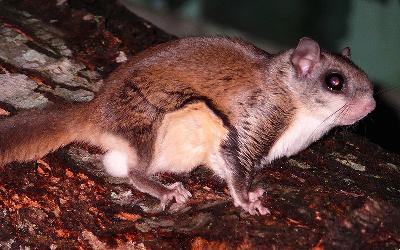Proudly serving Lake County IL, Eastern McHenry County and Northern Cook County
Flying Squirrel Removal & Control

(Glaucomys Volans)
Family: Flying Squirrels are the smallest member of the Squirrel (Sciuridea) family in Illinois.
Flying squirrels are brownish with a white belly and have large black eyes. They have a long flat tail, and flaps of skin between their front and rear legs. This extra skin is what allows them to glide through the air, similar to a parachute. While they can’t truly fly, it is reported that they can glide up to 100′.
Biology:
Size: Adults are around 8 ½ to 10 ½ inches long, including their tails.
Weight: Adults weigh between 1 ½ – 2 ½ ounces. Newborns weigh about 5 grams, as much as a nickel.
Reproduction: Female flying squirrels can have 2 litters a year. The first is born in April or May and the second litter arrives in August. Gestation lasts 40 days and the average litter size is 3 – 4 young.
Detrimental Consequences:
Flying squirrels commonly get into attics and are frequently heard during the night due to their nocturnal behavior. Squirrels will use attics as shelter or for a nursery site for their young. They tend to be solitary during the warmer times of the year, but during the winter several squirrels will occupy the same den and huddle together for warmth. It is not uncommon to have 6 – 10 flying squirrels using the same attic during the winter. Up to 20 squirrels will use the same den when in their natural setting. Occasionally flying squirrels will get into the living space of the home by falling down a chimney or locating a hole from the attic space. Neighborhoods that have mature trees are where we most commonly find them. They gain entry into attics through many different ways, including: roof vents, attic fans, gable vents, eave dormers, construction gaps, gutter lines, flashing, ridge vents. They seem to prefer large homes with cedar shake roofs which makes them a challenge to solve.
Control Measures:
The best way to deal with a flying squirrels problem is to identify the entry point that the squirrels are using and then to trap and remove the problem squirrels. Locating the entry points for flying squirrels requires a detailed inspection. Their small size allows them to get into openings that are 1″ square. Once the problem squirrels have been removed, the entry point and other possible openings should be sealed or animal proofed to prevent problems in the future.
Other Considerations: Flying squirrels are not commonly seen because they are nocturnal and arboreal. They are commonly confused for chipmunks or young grey squirrels. They are rarely ever seen on the ground and spend most of their waking hours searching for food by gliding from tree to tree, or tree to roof top. When we receive a call that someone has seen a baby squirrel we think Flyers. It is very easy for inexperienced pest and wildlife control operators to misdiagnose a flying squirrel problem as a mouse problem. There are specific signs that indicate the presence of Flying Squirrels, one of which is a distinct odor. It is prudent to positively identify if Flying Squirrels is the problem because the solution is different than that of mice.
Do you have a WILDLIFE EMERGENCY? We're ready to help.
SAME DAY SERVICE
Available!


